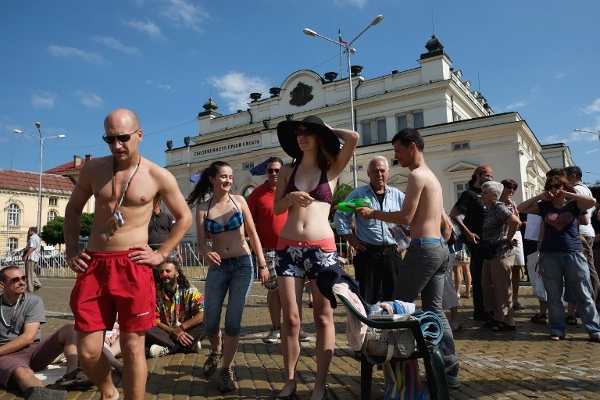Note from the LeftEast editors: this article has been published in cooperation with the Balkan web-portal Bilten.Org. It can be read in Serbo-Croatian here.
The number of cognitive workers in Bulgaria has been on the rise over the last years with the newly outsourced contact/call/logistics centers, telecommunication firms and IT support and development. By the end of 2013 about 70 000 were employed in the sector, 30 000 in IT alone. This segment of the working class enjoys the highest income levels – average salary is about 850 EUR with a national average of solely 200 EUR. This broad range of workers, along with other segments of the cognitive workforce (designers, artists, etc.), is usually subsumed under the rubric of the “new middle/creative class”. However, it is not only high-income parts workers that are identified as such, but also public employees, journalists, government and NGO bureaucrats, university staff and professors, among others.
Despite their differences, they are politically articulated via narratives of the new middle or creative class. This could be seen in mass political mobilizations, such as the one in the summer of 2013, or in the environmentalist movement. This political formation is present also in liberal “right to the city” mobilizations, that is to say around architectural heritage, and not, for instance, social housing.
In terms of sheer numbers this is surely not the most important part of the workforce. Nevertheless, they prove to provide hegemonic justifications of contemporary liberal capitalism in Bulgaria. Certain social positions (university professors or journalists) enable them to frame the coordinates of public debates and legitimate political distinctions and identities.
This is not to argue that liberal or middle-class identifications are novel in Bulgaria, but, especially since 2009, we do witness a new trend. What was importantly inherited from liberal mobilizations of the 1990s, however, are calls for democratization, civil society development, and anti-communism. But if mass anti-communist mobilizations of the 1990s promised socialism will be displaced with a more just and egalitarian social structure, free of arbitrary state violence, the new liberal anti-communism is much more elitist. In the 1990s it was not uncommon to see slogans such as “Power to the people! NO to communism” or “Down with the red bourgeoisie”. But now many protesters held posters saying “We could pay our bills alone”. Even more eccentric were last summer’s riots in support of austerity. Now, with the unfolding of the crisis, the “middle class” is becoming much more exclusive category, claiming to represent only a tiny entrepreneurially-minded elite of “creators of value”. As some of its intellectuals famously stated last year, this is “not the quantity, but the quality of the nation”. The “creative class” claimed to be enraged by the fact that the government wants to increase budget deficit from 1 to 2% and hence redistribute and “steal” the value they claim to have accumulated themselves. The middle or creative class is diverse in terms of its relation to capital, but it is being retroactively articulated as a coherent agent in political and cultural practice. Let us take a closer look at the conditions that enable high income cognitive workers, low-income public media journalists, public university professors, precarious NGO bureaucrats, artists and designers, along with activists from industrial unions to stand together and recognize themselves in a common political form which protests when fiscal discipline is in danger.
The similarities between those that recognize themselves as middle class are conditioned by a variety of print and online lifestyle blogs and publications, right-wing dailies and weeklies with liberally biased political commentaries, as well as cultural events (like TEDxBG). Widely read is not only the self-help literature, but also the countless biographies of Steve Jobs, Ayn Rand and the works of Malcolm Gladwell and Richard Florida.
 These types of workers often share common physical space. A few coworking spaces were established in the last years, such as one called Betahaus, or another called Soho. The owners of both were actively involved in the pro-austerity, anti-communist movement of the summer of 2013. For example, Betahaus’ managers provided office equipment and free Wi-Fi connection in front of Parliament in July, so that protesters can willingly work while at the same time fulfil their civic duties.
These types of workers often share common physical space. A few coworking spaces were established in the last years, such as one called Betahaus, or another called Soho. The owners of both were actively involved in the pro-austerity, anti-communist movement of the summer of 2013. For example, Betahaus’ managers provided office equipment and free Wi-Fi connection in front of Parliament in July, so that protesters can willingly work while at the same time fulfil their civic duties.
A person should spend 120 euro in order to rent a desk for a month at the co-working spaces. Some of the people working from their laptops at coffee shops actually enjoy the perks of being a part of a formal organization. For example, they rely on the organization’s team, contacts and its various social connections. But they unburden themselves from the load and costs of technical equipment, and from administrative duties. Despite the seeming flexibility that these conditions presuppose, the low and insecure income requires from these workers that they dedicate a lot more time to their jobs. Freelancers working at coffices and co-working spaces say that their work day spans from 10 to 14 hours, and the weekend is no exception. The work day at a coffice or a co-working space is also a work day that is no longer free of consumption: you are constantly tempted by muffins, cupcakes and lattes, fruits provided by local organic food cooperatives, alternative gigs, exhibitions and DIY workshops.
The expansion of outsourcing is transforming not only Sofia’s central parts. The biggest achievement of the so-called “creative” industry is located in the eastern part of Sofia: a 300 000 sq. m business park, hosting, among others, HP’s huge back office and IBM’s global delivery centre. The business park is a small version of a city: with restaurants and coffee shops, grocery stores, cinema, hotel, post office. Here one’s workday is also not devoid of consumption: everyone is engaged in trainings, relaxation activities, team buildings, or just let yourself be entertained.
Still, we cannot subsume all cognitive workers into one: even those engaged in productive practices (say designers) do not always sell their abstract labour power, separated from the means of production, to the capitalist, but have to self-exploit themselves and extraction of value is done via licenses, control over access to markets, social networks, etc. Thus there is a constant urge to revolutionize the productivity of one’s own labour power by a wide range of self-help practices or the active participation in relevant social networks by say unpaid labour. A number of NGOs specialized in disciplining this segment of the workforce, organizing “trainings” on “how to be creative”, “becoming a changemaker”, “lifelong learning”, “entrepreneurship”. Most of those cognitive precarious workers are however subjected to more standard forms of capitalist discipline in various office spaces, being employed directly by capital, say by the newly outsourced big IT corporations.
All of this, binded with precarious income and working conditions, creates huge and permanent inequalities within the cognitive workforce. Other lines of distinction are drawn within and between the ranks of NGO employees, journalists, artists, public employes and university professors. With the onset of “new public management” and generally the penetration of the market logic into the public sector – public employees are subjected to bourgeois forms of discipline. For example, university professors and school teachers cannot survive on their salaries alone, but have to constantly apply for temporal projects for public or private funding. This is coupled with efficiency assessments on which their salary depends, pitting against each other individual workers as well as institutions (public schools and universities, public theatres, etc.).
The dominant critique of the “middle class” in Bulgaria tends to be rather simplistic, addressing it as an immediate social fact. That is to say as a thing in itself, disregarding the social conditions that allow various practices to appear as a coherent whole. In its worst form, this critique sees some coherent comprador bourgeoisie where a much more complicated array of class positions exists. This position is blind to the internal inequalities within the so-called middle class in general. This pseudo populism rests on a normative and exclusionary understanding of “the people”, limited to ‘the common Bulgarians’ or ‘the pensioner’. It is the victimized ‘pensioner’ that is often raised by the mainstream left, namely the BSP, against the last summer’s protesters from the self-styled middle class. The liberal elite and the mainstream left agree that the members of the “creative class” share identical space within relations of production and that what is needed is redistribution of value supposedly produced by the “middle class” towards welfare for the passive pensioners, ethnic minorities, the sick, the unemployed, and “the poor” in general. For instance, Georgi Ganev, a mainstream liberal “expert”, wrote in 2013 that “the bourgeoisie is the only adversary of the coalition between the poor and the oligarchs”. The acceptance of the neoliberal framing of the class structure of Bulgarian society is not solely empirically and conceptually confused, but moreover it gives up the battle for hegemony before it had even started.
 Madlen Nikolova is a Cultural Studies student. She is а founding member of social center Haspel (Sofia) and of New Left Perspectivescollective. She also writes for Hysterical Parrhesia (blog for Marxist critique of ideology).
Madlen Nikolova is a Cultural Studies student. She is а founding member of social center Haspel (Sofia) and of New Left Perspectivescollective. She also writes for Hysterical Parrhesia (blog for Marxist critique of ideology).

